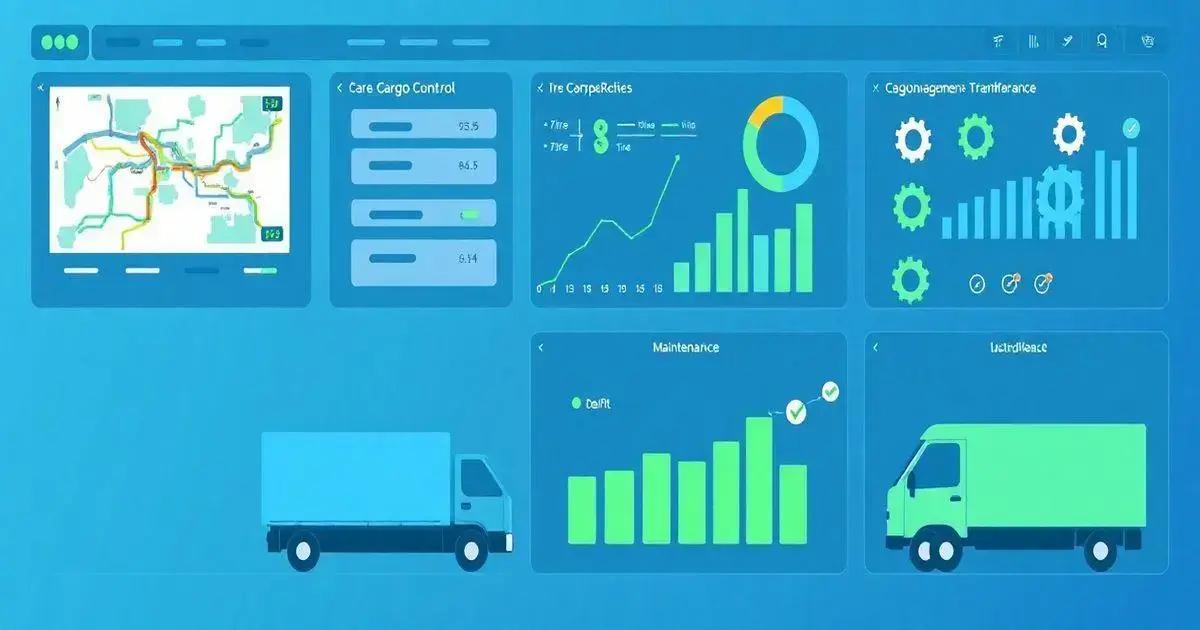7 Reasons to Use Fleet Control Worksheet 7.0 in Your Business Leave a comment
The Fleet Control Worksheet 7.0 is a vital tool for businesses aiming to improve fleet management by providing features like maintenance tracking, cost analysis, and an overview dashboard, which help in reducing operating costs and enhancing vehicle performance.
The Fleet Control Worksheet 7.0 is an essential tool for businesses looking to optimize their vehicle management and logistics operations. With features like travel and cargo control, tire management, and maintenance tracking, this worksheet offers comprehensive solutions for fleet oversight.
Overview of Fleet Control Worksheet 7.0
The Fleet Control Worksheet 7.0 is designed specifically for businesses that rely on a fleet of vehicles. This comprehensive tool helps streamline various aspects of fleet management, making it easier to track and analyze critical data related to vehicle operations. With its user-friendly interface, this worksheet allows you to efficiently monitor everything from fuel consumption to maintenance schedules.
One of the standout features of the Fleet Control Worksheet 7.0 is its Initial Dashboard, which provides a visual overview of key performance metrics. You can quickly see how much mileage each driver is accumulating, the average fuel consumption per vehicle, and the total costs associated with maintenance and repairs.
This worksheet not only aids in keeping records but also supports strategic decision-making. For example, by analyzing travel and cargo control data, businesses can optimize routes and reduce fuel costs, leading to improved operational efficiency.
Furthermore, the worksheet enables you to maintain detailed records of preventive and corrective maintenance, ensuring that all vehicles are running at peak performance. By keeping track of tire maintenance and other essential repairs, you can avoid unexpected breakdowns and extend the lifespan of your fleet.
In summary, the Fleet Control Worksheet 7.0 is a vital asset for companies looking to enhance their fleet management processes. With its ability to provide real-time insights and data, it empowers businesses to make informed decisions that drive efficiency and cost savings.

Key Features and Benefits
The Fleet Control Worksheet 7.0 comes packed with a variety of features designed to enhance fleet management and bring numerous benefits to your business. Here’s a breakdown of the key features and their advantages:
1. Comprehensive Dashboard
At a glance, the Initial Dashboard provides a visual representation of critical metrics such as:
- KM by Driver: Easily track the mileage logged by each driver, ensuring accountability.
- Average Consumption: Assess fuel efficiency across the fleet, helping identify areas for improvement.
2. Maintenance Tracking
The worksheet allows for meticulous tracking of both preventive and corrective maintenance. You can:
- Log Maintenance Activities: Keep a detailed record of all maintenance performed on each vehicle.
- Scheduling: Set reminders for upcoming services, ensuring no maintenance tasks are overlooked.
3. Cost Analysis
Gain valuable insights into the total cost of ownership of your fleet:
- Maintenance Costs: Track and analyze your spending on repairs and services.
- Fuel Expenses: Monitor fuel consumption and costs, enabling budget adjustments as needed.
4. Document Management
Efficient document management features enable you to:
- Control Driver and Vehicle Documentation: Keep all relevant documents organized, reducing the risk of fines or legal issues.
- Track Expiration Dates: Ensure all important documents are up to date.
5. User-Friendly Interface
The worksheet is designed for ease of use, allowing users of all technical abilities to navigate and input data without hassle. This ensures that you spend less time learning the tool and more time leveraging its capabilities.
6. Enhanced Decision Making
With real-time data and analytics at your fingertips, you can make informed decisions that improve overall fleet efficiency, reduce costs, and enhance service delivery.
In summary, the Fleet Control Worksheet 7.0 is more than just a tracking tool; it’s an all-in-one solution that empowers businesses to optimize their fleet operations effectively.
How to Implement the Worksheet
Implementing the Fleet Control Worksheet 7.0 in your business is a straightforward process that can lead to significant improvements in fleet management. Here’s a step-by-step guide to help you get started:
1. Download the Worksheet
The first step is to download the Fleet Control Worksheet 7.0 from the official website. Ensure that you have the latest version to access all the recent features and updates.
2. Install Required Software
This worksheet is compatible with Microsoft Excel. Make sure you have a version of Excel installed on your computer (2007 or newer) and that your system meets the minimum requirements:
- Windows 7, 8, 8.1, or 10
- At least 2GB of RAM
3. Familiarize Yourself with the Layout
Open the worksheet and take some time to explore its layout. Familiarize yourself with different sections, including:
- Dashboard: Displays key performance indicators.
- Data Entry Tabs: Where you will log information about your vehicles, drivers, and maintenance tasks.
4. Input Your Fleet Data
Start by entering details about your fleet:
- Vehicle Information: Enter data such as make, model, license plate number, and VIN.
- Driver Details: Log driver names, contact information, and assigned vehicles.
5. Set Up Maintenance Schedules
Utilize the maintenance tracking feature to set up a schedule for your vehicles:
- List all maintenance tasks required for each vehicle.
- Set reminders for upcoming maintenance activities to ensure timely service.
6. Train Your Team
Ensure that your team understands how to use the worksheet effectively. Provide training sessions to go over:
- Data entry procedures
- How to access and interpret dashboard metrics
7. Regularly Update the Data
Keep the worksheet up to date by regularly entering new data as your vehicles undergo maintenance, fuel refills, or any other relevant changes. Consistent updates will enhance the accuracy of your reports and insights.
8. Analyze and Optimize
Use the insights gained from the worksheet to make informed decisions. Analyze trends in fuel consumption, maintenance costs, and overall vehicle performance to identify opportunities for cost savings and efficiency improvements.
By following these steps, you will be well on your way to implementing the Fleet Control Worksheet 7.0 successfully in your organization, leading to improved fleet management and operational efficiency.

Common Challenges in Fleet Management
Managing a fleet can be a complex task, and various challenges can arise that may hinder efficiency and increase operational costs. Understanding these challenges is crucial for effective fleet management. Here are some common challenges faced by businesses:
1. High Operating Costs
One of the most significant challenges in fleet management is controlling overall operating costs. This includes expenses related to:
- Fuel
- Maintenance and repairs
- Insurance
Without proper tracking and management, these costs can quickly escalate, impacting profitability.
2. Vehicle Maintenance Issues
Neglecting regular maintenance can lead to unexpected breakdowns and costly repairs. Additionally, delayed maintenance can:
- Reduce vehicle lifespan
- Impact safety and compliance
Creating a proactive maintenance schedule is essential to overcoming this challenge.
3. Compliance and Regulations
Fleet managers must ensure that their operations comply with various regulations, including:
- Vehicle registration laws
- Driver licensing requirements
- Environmental regulations
Failure to comply can result in fines and legal issues, adding additional stress to fleet management.
4. Data Management and Analysis
With the growing amount of data generated from fleet operations, managing and analyzing this information can be overwhelming. Without the right tools, it becomes difficult to:
- Identify trends in performance
- Make informed decisions based on data insights
Utilizing a comprehensive worksheet like the Fleet Control Worksheet 7.0 can help address this issue.
5. Driver Management and Safety
Maintaining a skilled and safe driving team is vital for fleet success. Challenges in this area include:
- Monitoring driver behaviors (e.g., speeding, harsh braking)
- Providing ongoing training and support
- Managing driver turnover
Implementing driver monitoring systems can help improve safety and reduce accidents.
6. Fuel Efficiency
Fuel is a primary expense in fleet operations, and achieving optimal fuel efficiency is often a challenge. Factors that impact fuel efficiency include:
- Route optimization
- Vehicle types and conditions
- Driving habits
Regularly analyzing fuel usage data can highlight areas for improvement and help reduce fuel costs.
7. Unexpected Events
Natural disasters, economic fluctuations, and other unexpected events can disrupt fleet operations. Being prepared for such occurrences requires:
- Contingency planning
- Flexible resource allocation
Having a robust strategy in place can help fleets respond effectively to these challenges.
By recognizing and addressing these common challenges in fleet management, businesses can implement more effective strategies that lead to improved efficiency and cost savings.
Real-Life Success Stories
Real-life success stories can provide valuable insights and inspiration for businesses considering the Fleet Control Worksheet 7.0. Here are a few examples of organizations that have successfully implemented this tool to enhance their fleet management:
1. ABC Logistics
ABC Logistics, a mid-sized transportation company, faced challenges with rising fuel costs and inefficient routing. By implementing the Fleet Control Worksheet 7.0, they were able to:
- Track fuel consumption per vehicle and identify fuel-wasting habits.
- Analyze driver performance data to promote better driving behaviors.
- Optimize delivery routes based on real-time data, reducing fuel costs by 15% within the first six months.
This resulted in significant savings and improved customer satisfaction due to timely deliveries.
2. XYZ Construction
XYZ Construction operates a fleet of heavy machinery and vehicles, and they struggled with maintaining equipment and managing maintenance schedules. After adopting the Fleet Control Worksheet 7.0, they achieved the following:
- Logged all maintenance activities, enabling proactive scheduling and reducing downtime.
- Lowered maintenance costs by 20% by avoiding late repairs and extending vehicle lifespans.
- Improved compliance with safety regulations by ensuring all vehicles were properly maintained and documented.
The company not only saved costs but also enhanced overall operational efficiency.
3. Quick Freight Co.
Quick Freight Co. operates in a competitive market and recognized the need for better fleet management to stay ahead. By utilizing the Fleet Control Worksheet 7.0, they accomplished:
- A comprehensive overview of vehicle performance, leading to smarter purchasing decisions.
- Better tracking of driver hours and compliance with labor regulations, reducing the risk of penalties.
- Increased visibility into their fleet operations, which helped them pinpoint areas for cost reduction.
As a result, Quick Freight Co. saw an increase in profitability and improved operational transparency.
4. Green Transport Solutions
With a mission to reduce their carbon footprint, Green Transport Solutions sought to optimize fuel efficiency. By implementing the Fleet Control Worksheet 7.0, they were able to:
- Monitor fuel usage patterns and identify opportunities for eco-friendly driving practices.
- Implement route optimization techniques to lower fuel consumption.
- Reduce their overall emissions by 12%, aligning with their sustainability goals.
This not only showcased their commitment to the environment but also attracted environmentally conscious clients.
These success stories highlight how the Fleet Control Worksheet 7.0 can transform fleet management practices. By adopting this tool, businesses can enhance efficiency, reduce costs, and achieve their operational goals effectively.

Conclusion and Next Steps
In conclusion, the Fleet Control Worksheet 7.0 serves as an invaluable tool for businesses aiming to optimize their fleet management processes. From tracking maintenance schedules to monitoring fuel consumption, this worksheet provides a comprehensive solution that can lead to significant operational efficiencies and cost savings.
Implementing the worksheet not only enhances visibility into vehicle performance but also empowers fleet managers to make informed decisions that improve overall productivity. As demonstrated in the success stories of various organizations, utilizing this tool can lead to substantial improvements in fleet operations.
Next Steps:
- Download the Fleet Control Worksheet 7.0: Start by obtaining the latest version from the official website to ensure you have all the newest features and updates.
- Train Your Team: Provide thorough training for your staff on how to effectively use the worksheet and interpret the data it generates.
- Input Your Fleet Data: Begin entering relevant data about your vehicles and drivers to start monitoring and managing your fleet effectively.
- Set Up a Maintenance Schedule: Use the worksheet to create a proactive maintenance schedule, helping to minimize unexpected breakdowns and repair costs.
- Analyze the Data Regularly: Schedule regular reviews of the data to identify trends and areas for improvement. Use this analysis to make informed decisions about fleet operations.
- Adjust Strategies as Needed: Be flexible in your approach and ready to make adjustments based on the insights gained from the worksheet.
By taking these steps, your business can leverage the Fleet Control Worksheet 7.0 to enhance fleet management, reduce costs, and improve overall operational efficiency. Start your journey toward better fleet management today!
Conclusion
The Fleet Control Worksheet 7.0 is an essential tool for businesses looking to streamline their fleet management processes.
By effectively tracking vehicle performance, maintenance schedules, and costs, companies can make informed decisions that enhance operational efficiency and reduce expenses.
With its user-friendly interface and comprehensive features, this worksheet empowers fleet managers to proactively manage their fleets and address challenges before they escalate.
From improving fuel efficiency to ensuring timely maintenance, the benefits of adopting this tool are clear.
As more businesses recognize the importance of efficient fleet management, implementing the Fleet Control Worksheet 7.0 can provide a significant competitive edge.
Start leveraging its capabilities today to optimize your fleet operations and drive your business toward success.
FAQ – Frequently Asked Questions about Fleet Control Worksheet 7.0
What is the Fleet Control Worksheet 7.0?
The Fleet Control Worksheet 7.0 is a comprehensive spreadsheet tool designed for managing fleet operations, including tracking vehicle performance, maintenance, and costs.
How can the worksheet help my business?
It helps streamline fleet management processes, reduces operating costs, improves fuel efficiency, and ensures timely maintenance, leading to overall operational efficiency.
Is the worksheet compatible with all versions of Excel?
Yes, the Fleet Control Worksheet 7.0 is compatible with Excel versions 2007 and newer.
Can multiple users access the worksheet simultaneously?
The worksheet is designed for single-user access. However, you can share the file, but make sure to manage data updates to avoid conflicts.
What kind of data do I need to input into the worksheet?
You will need to input data such as vehicle details, driver information, maintenance records, fuel consumption, and costs associated with operations.
Is there support available if I encounter issues with the worksheet?
Yes, technical support is available via email or WhatsApp for any issues related to the worksheet.

